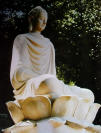
The circle just inside the five sectors of beings indicates that these levels of suffering are produced by karma--by actions. It is in two halves. The half on the right, which has a white base with people looking and moving upward, symbolizes virtuous actions, these being of two types, meritorious and unfluctuating; such actions are the means of attaining lives as humans, demi-gods, and gods. The left half, which has a dark base with people facing downward, symbolizes non-virtuous actions, which impel lifetimes in the lower realms.
From what do these karmas that are sources of suffering arise? They stem from a further source of suffering--the afflictive emotions of desire, hatred and ignorance--indicated by the innermost circle where a pig, a snake, and a rooster are drawn. The pig symbolizes ignorance; the snake, hatred; and the rooster, desire. In some versions of the painting, the tails of the rooster and the snake are grasped by the mouth of the pig, thereby indicating that desire and hatred have ignorance as their root. Also, the tail of the pig is grasped in their mouths to indicate that each of them acts to assist and further the other.
The symbolism of these three circles, moving from the center outwards, is that the three afflictive emotions of desire, hatred, and ignorance give rise to virtuous and non-virtuous actions, which, in turn, give rise to the various levels of suffering in cyclic existence. The outer rim symbolizing the twelve links of dependent-arising indicates how the sources of suffering-- actions and afflictive emotions--produce lives within cyclic existence. The fierce being holding the wheel symbolizes impermanence. If I may make a joke, it does not symbolize a creator-deity!
The essential point is to symbolize impermanence; this is why the being is a wrathful monster, though there is no need for it to be drawn with ornaments and so forth as it is here. Once I had such a painting drawn with a skeleton rather than a monster, in order more clearly to symbolize impermanence.
The moon on the far right side indicates liberation. The Buddha on the left is pointing to the moon, indicating that the liberation that causes one to cross the ocean of suffering of cyclic existence should be actualized.
With regard to the history of this painting, at the time of Shakyamuni Buddha, an outlying king, Udayana, made a present of a jewelled robe to the king of Magadha, Bimbisara, who did not have anything of equivalent worth to give in return. Bimbisara was worried about this and asked Buddha what he should give. Buddha indicated that he should have a wheel of cyclic existence with five sectors drawn and have the following stanzas put with it:
Undertaking this and
leaving that,
Enter into the teaching of the Buddha.
Like an elephant in a thatch house,
Destroy the forces of the Lord of Death.
Those who with thorough
conscientiousness
Practice this disciplinary doctrine
Will forsake the wheel of birth,
Bringing suffering to an end.
Buddha told Bimbisara to send this to King Udayana. It is said that when the king received the picture and studied it, he attained realizations.
The twelve links of dependent- arising are symbolized by the twelve pictures around the outside. The first, at the top--an old person, blind and hobbling with a cane--symbolizes ignorance, the first link. In this context, ignorance is obscuration with respect to the actual mode of being of phenomena. Since within, the Buddhist philosophical schools there are four main systems of tenets and, within those schools, there are many different divisions, there are many interpretations of what ignorance is. Not only do we not have time to discuss all of these, I do not even remember all of them!
In general, with respect to ignorance, there is a factor that is a mere non- knowing of how things actually exist, a factor of mere obscuration. Also, in Sutra, nineteen different types of ignorance are described--various types of wrong views related with extreme positions. However, here in the twelve links of dependent arising, ignorance is explained to be a wrong consciousness that conceives the opposite of how things actually do exist.
Ignorance is the chief of the afflictive emotions that we are seeking to abandon, each of which is of two types, innate and intellectually acquired. Intellectually acquired afflictive emotions are based on inadequate systems of tenets, such that the mind imputes or fosters new afflictive emotions through conceptuality. These are not afflictive emotions that all sentient beings have and cannot be the ones that are at the root of the ruination of beings--the latter are innate.
As Nagarjuna says in his Seventy Stanzas on Emptiness:
That consciousness conceiving
things--which are produced
In dependence upon causes and conditions--to ultimately exist
Was said by the Teacher to be ignorance.
From it the twelve links arise.